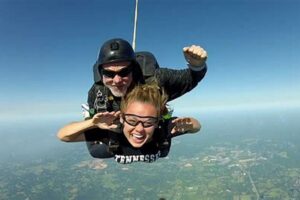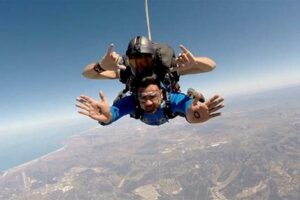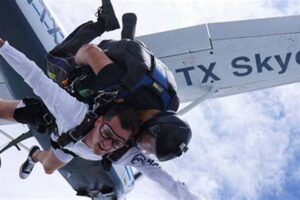Table of Contents
Skydiving certification involves obtaining the necessary training and credentials to perform skydives safely and legally. For instance, the United States Parachute Association (USPA) provides various certification levels for skydivers, ranging from novice to expert.
Skydiving certification is crucial for ensuring safety and proficiency in the sport. It provides individuals with the knowledge, skills, and experience required to navigate the risks associated with skydiving. Moreover, certification opens doors to competitive skydiving events and advanced training opportunities. Historically, the development of the static line in the 1950s played a pivotal role in making skydiving more accessible and paved the way for the modern certification system.
This article will delve into the intricacies of how to get skydive certified, including the necessary training steps, certification levels, and the importance of ongoing education and safety practices.
How to Get Skydive Certified
Skydive certification entails acquiring the necessary training and credentials to perform skydives safely and legally. Understanding the key aspects of skydive certification is essential for a comprehensive grasp of the subject matter.
- Training
- Certification Levels
- Safety Regulations
- Equipment
- Medical Requirements
- Weather Conditions
- Drop Zone
- Ongoing Education
These aspects are interconnected and influence each other. For instance, training involves learning the proper techniques and procedures for skydiving, which is essential for achieving the required certification levels. Safety regulations govern the conduct of skydiving activities, ensuring the well-being of participants and spectators, and compliance with these regulations is a key aspect of skydive certification. Ongoing education is crucial for maintaining proficiency and adapting to evolving safety standards and best practices in the sport.
Training
Training is the cornerstone of skydive certification, providing individuals with the knowledge, skills, and experience necessary to perform skydives safely and competently. It encompasses various facets, each playing a critical role in preparing skydivers for the challenges and responsibilities of the sport.
- Ground School: Theoretical instruction covering principles of skydiving, safety procedures, equipment usage, and emergency protocols, providing a strong foundation for practical training.
- Tandem Jumps: Initial jumps performed with an experienced instructor securely attached, allowing students to experience the sensation of freefall while under direct supervision.
- Solo Jumps: Supervised jumps where students deploy their own parachutes and control their descent, gradually building confidence and independence.
- Advanced Training: Optional but highly recommended training for experienced skydivers seeking to enhance their skills, specialize in specific disciplines, or prepare for competition.
Through a combination of theoretical knowledge, practical experience, and progressive challenges, training empowers skydivers with the requisite capabilities to make informed decisions, respond appropriately to changing conditions, and mitigate risks associated with the sport.
Certification Levels
Certification levels are a crucial aspect of skydive certification, as they establish a structured progression for skydivers to develop their skills and experience. These levels provide a clear roadmap for advancement, ensuring that skydivers possess the necessary knowledge, proficiency, and safety consciousness to participate in the sport at increasingly challenging levels.
- A-License: The foundational level of skydive certification, typically requiring a minimum number of solo jumps and demonstrating proficiency in basic skydiving maneuvers.
- B-License: An intermediate level that builds upon the A-License, introducing more advanced maneuvers, canopy control techniques, and emergency procedures.
- C-License: An advanced level that signifies a high degree of proficiency and experience, requiring skydivers to master complex maneuvers, formation skydiving, and specialized jump types.
- D-License: The highest level of skydive certification, reserved for highly experienced and skilled skydivers who have demonstrated exceptional proficiency in all aspects of the sport.
Certification levels serve as benchmarks for skydivers to track their progress, set goals, and continuously improve their skills. They also provide a system of recognition and accomplishment, motivating skydivers to strive for higher levels of proficiency and safety.
Safety Regulations
Safety regulations are an indispensable aspect of skydive certification, providing a framework to ensure the well-being of participants and spectators alike. These regulations encompass a wide range of considerations, from equipment maintenance to weather conditions, and serve as the cornerstone of safe and responsible skydiving practices.
- Equipment Inspection: All skydiving equipment, including parachutes, harnesses, and altimeters, must undergo rigorous inspections to ensure proper functioning and compliance with safety standards.
- Weather Monitoring: Skydiving operations are heavily influenced by weather conditions, and strict regulations are in place to monitor wind speed, cloud cover, and visibility to minimize risks associated with adverse weather.
- Drop Zone Safety: Drop zones are carefully selected and managed to provide a safe landing area for skydivers, with clear airspace and designated landing patterns to avoid collisions.
- Emergency Procedures: Skydivers must be thoroughly trained in emergency procedures, such as parachute malfunctions and mid-air collisions, to respond effectively and mitigate potential hazards.
Adherence to safety regulations is paramount for skydive certification and the ongoing practice of the sport. These regulations provide a structured approach to risk management, ensuring that skydivers are equipped with the knowledge, skills, and equipment to participate in skydiving with a high degree of safety and confidence.
Equipment
Equipment plays a crucial role in skydive certification, serving as the foundation for safe and successful skydiving experiences. Without the proper gear, individuals cannot participate in the sport, highlighting the critical connection between equipment and how to get skydive certified.
Essential equipment for skydiving includes parachutes, harnesses, altimeters, and communication devices. Each component serves a specific purpose in ensuring the safety and well-being of skydivers. Parachutes, the most critical piece of equipment, provide the means for a controlled descent and safe landing. Harnesses securely attach skydivers to their parachutes and distribute the force of opening and landing. Altimeters allow skydivers to monitor their altitude and make informed decisions during their jumps. Communication devices enable skydivers to stay connected with each other and with ground personnel.
The practical applications of understanding the connection between equipment and skydive certification are evident in the training and certification process. Trainees receive thorough instruction on the proper use and maintenance of equipment, ensuring they are proficient in operating their gear safely and effectively. Certification requires skydivers to demonstrate their ability to pack and deploy their parachutes correctly, as well as to perform emergency procedures in the event of equipment malfunctions.
Medical Requirements
Medical requirements are an integral part of how to get skydive certified, ensuring that individuals are physically and mentally fit to participate in the sport. These requirements are designed to minimize risks and promote safety for all involved.
- Physical Health: Skydiving places significant demands on the body, and good physical health is essential. Candidates must undergo a medical examination to assess their overall health, including cardiovascular function, musculoskeletal system, and respiratory health.
- Mental Health: Skydiving requires clear thinking and sound judgment. Candidates must be free from any psychological conditions that could impair their ability to make quick decisions or respond appropriately to emergencies.
- Substance Use: Skydiving under the influence of alcohol or drugs is strictly prohibited. Candidates must abstain from substance use for a specified period before participating in any skydiving activities.
- Age and Experience: Age and experience requirements vary depending on the certification level being sought. However, all candidates must be of legal age and have a certain number of jumps before advancing to higher certification levels.
Meeting medical requirements is crucial for obtaining skydive certification. By ensuring that candidates are in good health and free from any conditions that could compromise their safety, these requirements help to create a safe and enjoyable skydiving experience for all.
Weather Conditions
In the context of skydive certification, weather conditions play a pivotal role in ensuring the safety and success of skydiving activities. Favorable weather conditions are essential for creating a safe environment for skydivers and minimizing potential risks.
-
Wind Speed and Direction:
Excessive wind speeds and unfavorable wind directions can affect the accuracy of landings and increase the risk of drift during freefall. Skydiving operations are typically suspended when wind speeds exceed certain limits.
-
Cloud Cover and Visibility:
Dense cloud cover and poor visibility can impair the skydiver’s ability to navigate and make safe landings. Skydiving is generally not permitted when cloud cover obscures the drop zone or surrounding airspace.
-
Temperature and Humidity:
Extreme temperatures and high humidity levels can affect the performance of skydiving equipment, particularly the deployment and inflation of parachutes. Skydiving operations may be adjusted or postponed to avoid adverse effects on equipment and skydiver safety.
-
Precipitation:
Rain, snow, or hail can create slippery surfaces and reduce visibility, making it hazardous for skydivers to land safely. Skydiving is typically not conducted in the presence of precipitation.
Understanding the impact of weather conditions is crucial for skydive certification. By carefully monitoring weather forecasts and adhering to established guidelines, skydivers can make informed decisions about whether to participate in skydiving activities and minimize the associated risks.
Drop Zone
In the context of skydive certification, the drop zone holds immense significance as the designated landing area for skydivers, playing a pivotal role in ensuring a safe and controlled descent. Understanding the various aspects of a drop zone is essential for skydive certification.
-
Landing Area:
The drop zone comprises a vast, open area that provides ample space for skydivers to land safely. It is typically marked with windsocks and other visual aids to assist skydivers in judging wind direction and speed.
-
Safety Equipment:
Drop zones are equipped with safety equipment such as foam pits or air bags to cushion the impact of landings, mitigating the risk of injuries. Emergency medical services are also readily available on-site to respond to any potential medical emergencies.
-
Communication and Coordination:
Effective communication and coordination are crucial at drop zones. Skydivers maintain radio contact with ground personnel throughout the jump, ensuring smooth coordination during landing and providing timely assistance if needed.
-
Designated Landing Patterns:
Drop zones have designated landing patterns to ensure orderly and safe descents. Skydivers follow these patterns to avoid collisions and maintain a safe distance from each other during their approaches.
Understanding drop zone characteristics is paramount for skydive certification as it equips skydivers with the knowledge and skills to navigate the landing area effectively. Proper training, adherence to safety protocols, and effective communication within the drop zone contribute to a safe and enjoyable skydiving experience.
Ongoing Education
In the realm of skydiving, the pursuit of knowledge and skill development extends beyond initial certification. Ongoing education plays an integral role in maintaining proficiency, adapting to evolving safety standards, and continuing the journey of skydiving excellence.
Skydiving is an inherently dynamic sport, with advancements in equipment, techniques, and safety protocols occurring regularly. Ongoing education ensures that skydivers remain abreast of these developments and incorporate best practices into their skydiving routines. Regular training sessions, workshops, and seminars provide opportunities for skydivers to refine their skills, learn from experienced professionals, and stay up-to-date with the latest industry knowledge.
Moreover, ongoing education fosters a culture of safety and risk awareness among skydivers. Through ongoing training, skydivers enhance their decision-making abilities, learn to identify and mitigate potential hazards, and develop a deep understanding of the factors that contribute to safe and successful skydives. By continuously investing in their education, skydivers empower themselves to make informed choices and minimize the risks associated with the sport.
In summary, ongoing education is an indispensable aspect of how to get skydive certified as it provides a pathway for continuous learning, adaptation, and the pursuit of excellence in the sport. Embracing ongoing education not only enhances skydivers’ skills and knowledge but also instills a deep commitment to safety, ensuring a fulfilling and long-lasting skydiving journey.
Frequently Asked Questions about Skydive Certification
This FAQ section aims to address common questions and clarify aspects related to skydive certification, providing valuable insights to prospective skydivers.
Question 1: What are the age and physical requirements for skydive certification?
Typically, individuals must be at least 18 years of age and meet certain physical health criteria, which can vary depending on the certification level and skydiving organization. A medical examination may be required to assess overall fitness and rule out any conditions that could impact skydiving safety.
Question 2: How long does it take to get skydive certified?
The time frame for skydive certification varies depending on the training program and the individual’s pace of progress. It can typically take several weeks to complete the necessary training and solo jumps required for certification.
Question 3: What are the different levels of skydive certification?
Skydive certification typically involves a progression of levels, such as A-License, B-License, C-License, and D-License. Each level requires a specific number of jumps, skill demonstrations, and theoretical knowledge, with higher levels indicating greater experience and proficiency.
Question 4: How much does skydive certification cost?
The cost of skydive certification varies depending on the skydiving school, location, and level of certification being pursued. It typically includes training, equipment rental, and the cost of jumps.
Question 5: What are the safety regulations for skydiving?
Skydiving is a highly regulated sport, with strict safety protocols in place to minimize risks. These regulations cover aspects such as equipment inspection, weather conditions, drop zone safety, and emergency procedures.
Question 6: Is skydiving a dangerous sport?
While skydiving involves inherent risks, it is generally considered a safe sport when proper training, equipment, and safety measures are followed. Skydiving organizations prioritize safety and implement comprehensive training programs and risk management strategies to minimize potential hazards.
These FAQs provide a glimpse into the key aspects and considerations related to skydive certification. Understanding these factors can help individuals make informed decisions about pursuing skydiving and navigate the certification process effectively. As we delve deeper into the topic, the following section will explore the various training options available for skydive certification.
Skydive Certification Tips
To enhance your skydive certification journey, consider these valuable tips:
Tip 1: Choose a Reputable Skydiving School: Opt for a school with experienced instructors, a strong safety record, and positive reviews.
Tip 2: Invest in Quality Gear: Reliable equipment is crucial for safety. Consider investing in a well-fitting jumpsuit, altimeter, and other necessary gear.
Tip 3: Train Consistently: Regular practice is essential for skill development. Attend training sessions and practice jumps to gain confidence and improve technique.
Tip 4: Mind Your Fitness: Skydiving requires physical fitness. Engage in exercises that strengthen your legs, core, and cardiovascular system.
Tip 5: Manage Weather Conditions: Skydiving is heavily influenced by weather. Monitor forecasts and understand how different conditions impact jump safety.
Tip 6: Stay Informed: Keep up with industry best practices, safety protocols, and equipment advancements to enhance your knowledge and decision-making.
Tip 7: Learn from Experienced Skydivers: Seek guidance from experienced skydivers. Their insights and tips can accelerate your learning and improve your skills.
Tip 8: Prioritize Safety: Always adhere to safety regulations, follow instructions, and make informed decisions to minimize risks.
By following these tips, you can increase your chances of a safe and enjoyable skydive certification experience. These principles will serve as a foundation for your ongoing skydiving journey.
As you progress in your certification, remember to continuously refine your skills, maintain your equipment, and stay abreast of safety advancements. These efforts will not only enhance your skydiving experience but also contribute to the overall safety and enjoyment of the sport.
Conclusion
This article has delved into the intricacies of skydive certification, providing a comprehensive overview for aspiring skydivers. Understanding the key aspects of training, certification levels, safety regulations, and ongoing education is essential for a successful and safe skydiving journey.
Three main points to consider are the importance of choosing a reputable skydiving school, investing in quality gear, and prioritizing safety. These factors are interconnected and contribute to a positive certification experience. Reputable schools ensure proper training and adherence to safety standards; quality gear enhances comfort and performance; and prioritizing safety minimizes risks and promotes a culture of responsible skydiving.
Skydive certification is not merely about obtaining a license but about embracing a lifelong pursuit of skill development and safety consciousness. By following the guidelines outlined in this article and continuously seeking knowledge and experience, skydivers can embark on a fulfilling and exhilarating journey in the skies.







